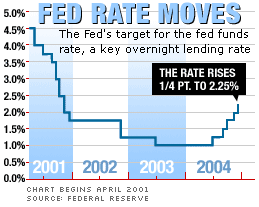NEW YORK (CNN/Money) -
The Federal Reserve raised a key short-term interest rate a quarter-percentage point Tuesday -- the fifth increase this year and one that was widely anticipated on Wall Street.
The central bank increased the target for its federal funds rate, an overnight lending rate that helps banks determine rates on many loans, to 2.25 percent from 2 percent.
The Fed's policy-making Open Market Committee said in a statement that inflation is expected to remain relatively low and that it would likely keep raising rates at a "measured" pace -- something it's been saying since it started raising rates in June, and also something that most investors and economists had been expecting.
"The Committee perceives the upside and downside risks to the attainment of both sustainable growth and price stability for the next few quarters to be roughly equal. With underlying inflation expected to be relatively low, the Committee believes that policy accommodation can be removed at a pace that is likely to be measured," the Fed's statement said.
With Tuesday's rate increase out of the way, most observers expect another quarter-point increase at the Fed's next meeting in February.
But what about the rest of 2005? The fed funds rate is now 125 basis points higher than the 1 percent level it began the year at but is still near a 40-year low. There are 100 basis points in one percent.
The Fed may have given some hints about its intentions with two slight changes in language compared to what it said when it raised the fed funds rate in November.

It acknowledged Tuesday that oil prices have eased from record levels and also seemed to allude to the fact that November's employment figures were not as robust as many economists had been predicting.
"Output appears to be growing at a moderate pace despite the earlier rise in energy prices, and labor market conditions continue to improve gradually," the Fed said. In its November statement, the Fed did not use the words "earlier" or "gradually".
This subtle change in wording, however, could be an indication from the Fed that it may not need to raise rates dramatically next year since inflationary pressures remain in check and that the economy, while growing, is not on the verge of overheating.
"I would infer from the statement that the Fed is somewhat more sanguine on the economic recovery," said Jack Ablin, Chief Investment Officer with Harris Private Bank. "Perhaps they believe that $55 oil prices are, at least for the time being, something of the past and that jobs are just improving at a moderate pace."
With that in mind, Ablin said he thinks the Fed is likely to raise rates one more quarter point at its next meeting in February, to 2.5 percent, but that it could pause for a bit after that.
Mark Zandi, chief economist with research firm Economy.com, said he thinks that the Fed still has more room to raise rates before it risks putting a significant dent in economic growth.
Zandi pointed out that even though the Fed has been ratcheting up short-term rates, long-term Treasury rates, which have a greater impact on mortgage rates and corporate bond rates, have not moved substantially higher since June. That could be a sign that the bond market is confident that the Fed is on the right track, he said.
And unless long-term rates creep up, the economy probably will remain on solid footing, Zandi added. "I don't think any of this will have a dramatic effect on the economy or spending unless long-term rates rise. A real economic impact only occurs when long-term rates raise," said Zandi.
Market observers believe that the Fed would like to boost rates to a so-called "neutral" level -- one that would neither encourage the economy to expand too rapidly or list into a funk, by the end of next year.
But there's little agreement on what exactly a "neutral" rate is, with estimates ranging from 2.5 percent to as high as 4 percent.
"It's been clear that the Fed concluded rates were too low," said Ed Yardeni, chief investment strategist with Oak Associates, a mutual fund firm. "But nobody knows for sure what to consider neutral." Yardeni added that he expects the Fed to gradually raise rates to at least 3 percent by the middle of next year.
Still, there is debate about just how strong the underlying economy really is, which could further complicate matters for the Fed.
"The Fed is now at the proverbial fork in the road," said Barry Ritholtz, chief market strategist for Maxim Group.
"There is a lot of economic news to digest between now and the next meeting. If we see economic signs that are positive, then that would encourage the Fed to stay on the course of gradual rate hikes, but if things slow down then maybe they would skip a meeting or two."
The market will not have to wait as long for further clues about how the Fed views the economy though. The Fed also announced it had unanimously voted to allow the minutes of policy meetings to be available three weeks after the meeting. That means minutes from Tuesday's meeting will be released on Jan. 4, before its next meeting in February.
Previously, the delay was much longer. For example, the minutes from the Fed's November meeting won't be available until this Thursday, Dec. 16.
On Wall Street, stocks extended their gains after the Fed's announcement.
The benchmark 10-year Treasury bond edged higher, pushing the yield down to 4.13 percent from 4.15 percent late Monday. Bond prices and yields move in opposite directions.
The Fed also raised the discount rate, largely viewed as a symbolic move, a quarter percentage point to 3.25 percent.

|